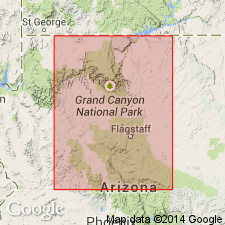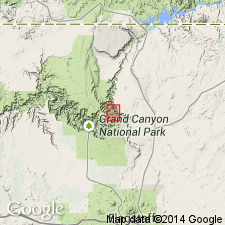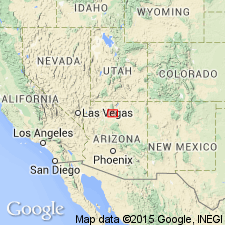
- Usage in publication:
-
- Jupiter Member
- Modifications:
-
- First used
- AAPG geologic province:
-
- Plateau sedimentary province
Summary:
First use of the Jupiter Member of the Galeros Formation of the Chuar Group. Age is late Precambrian.
Source: GNU records (USGS DDS-6; Menlo GNULEX).

- Usage in publication:
-
- Jupiter Member
- Modifications:
-
- [Principal reference]
- Dominant lithology:
-
- Shale
- Limestone
- AAPG geologic province:
-
- Plateau sedimentary province
- Southern Rocky Mountain region
Summary:
Pg. 1244 (table 1), 1245 (fig. 3), 1247-1248, 1257, geol. map (fig. 1), columnar section (fig. 2). Jupiter Member of Galeros Formation of Chuar Group. Upper 1,484 feet, vari-colored shale with calcareous siltstone in lowest few feet. Basal 32 feet, stromatolitic limestones associated with fragmental, laminated, argillaceous limestone. Total thickness 1,516 feet (462 m). Underlies Carbon Canyon Member (new) and overlies Tanner Member (new); both of Galeros Formation (new). Appears = Walcott's lower divisions 5, 6, 7, and 8 of Chuar terrane [USGS Ann. Rpt. 14, p. 508-509, 1894], and Hinds' division 3 and upper part of 2 of Chuar Group [Carnegie Inst. Washington Pub. 463, p. 105-106, 1936]. Fossils (stromatolites INZERIA, STRATIFERA). Age is late Precambrian.
Type section: Jupiter section B, [west of Chuar Lava Hill, north side Lava Creek, approx. Lat. 36 deg. 08 min. 42 sec. N., Long. 111 deg. 50 min. 24 sec. W., Cape Solitude 7.5-min quadrangle], eastern Grand Canyon, Grand Canyon National Park, Coconino Co., northern AZ.
Named from Jupiter Temple, which overlooks main outcrops in Basalt Canyon and Chuar Valley, [approx. Lat. 36 deg. 08 min. 05 sec. N., Long. 111 deg. 53 min. 24 sec. W., southeastern corner Walhalla Plateau 7.5-min quadrangle], eastern Grand Canyon, Grand Canyon National Park, Coconino Co., northern AZ.
[Additional locality information from USGS GNIS database and USGS historical topographic map collection TopoView, accessed on October 5, 2024.]
Source: Publication; supplemental information from US geologic names lexicon (USGS Bull. 1520, p. 158-159).

- Usage in publication:
-
- Jupiter Member*
- Modifications:
-
- Adopted
- AAPG geologic province:
-
- Plateau sedimentary province
Summary:
Jupiter Member of the Galeros Formation of the Chuar Group of Ford and Breed (1973) is adopted as the Jupiter Member of the Galeros Formation of the Chuar Group of the Grand Canyon Supergroup. Age is late Precambrian.
Source: GNU records (USGS DDS-6; Menlo GNULEX).

- Usage in publication:
-
- Jupiter Member*
- Modifications:
-
- Age modified
- AAPG geologic province:
-
- Plateau sedimentary province
Summary:
Age of the Jupiter Member of the Galeros Formation is modified from late Precambrian to: Proterozoic Y.
Source: GNU records (USGS DDS-6; Menlo GNULEX).

- Usage in publication:
-
- Jupiter Member*
- Modifications:
-
- Age modified
- AAPG geologic province:
-
- Southern Rocky Mountain region
Summary:
Is one of four members of Galeros Formation of Chuar Group of Grand Canyon Supergroup. Is 400 m thick. Age designation of Proterozoic Y changed to Late Proterozoic, the age term applied to rocks younger than 900 Ma and older than 570 Ma. Change in age designation made to Galeros and its Tanner (base), Jupiter, Carbon Canyon, and Duppa Members in the Southern Rocky Mountain region of northern AZ. Columnar section.
Source: GNU records (USGS DDS-6; Denver GNULEX).
For more information, please contact Nancy Stamm, Geologic Names Committee Secretary.
Asterisk (*) indicates published by U.S. Geological Survey authors.
"No current usage" (†) implies that a name has been abandoned or has fallen into disuse. Former usage and, if known, replacement name given in parentheses ( ).
Slash (/) indicates name conflicts with nomenclatural guidelines (CSN, 1933; ACSN, 1961, 1970; NACSN, 1983, 2005, 2021). May be explained within brackets ([ ]).

